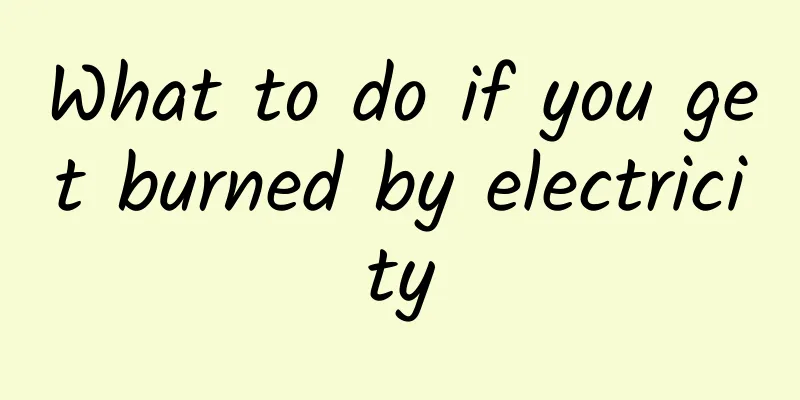What to do if you get burned by electricity

|
Accidents are everywhere. In our daily lives, we may cut our hands while working, sprain our ankle while walking, or get electrocuted by a power socket leak while cooking. Many accidents catch us off guard. Everyone knows that electric current generates heat. What should we do if we accidentally get electric shock and burns? Here are some first aid methods for electrical burns. In life, if there is leakage of electricity or electric shock, it may cause electric burns to the hands. Because the electric current will generate heat in the tissue and cause damage to tissue protein, this phenomenon is called electric burns. Generally speaking, the conditions of patients with electric burns are relatively serious, and only reasonable treatment can reduce the damage caused by electric burns to the body. This can be handled in the following ways. 1. First aid on the spot . Once an electrical burn occurs, the patient should be immediately isolated from the power source using insulating objects. If the patient experiences respiratory and cardiac arrest, cardiopulmonary resuscitation should be performed immediately. 2. Comprehensive inspection . You should learn more about the patient's medical history and check whether the patient has brain injury, internal organ injury and fracture. Patients with cardiac arrhythmia should be monitored in the ICU. 3. Fluid resuscitation . Fluids should be replenished according to the area of electrical burns on the patient to avoid serious kidney damage. The amount of infusion needs to be comprehensively weighed according to the patient's condition and closely monitored. 4. Prevent anaerobic bacterial infection. Since electrical burns are open injuries, patients may experience extensive necrosis of deep tissues and are extremely susceptible to infection. Patients should take anti-inflammatory drugs appropriately, such as cephalosporin, erythromycin, amoxicillin-sulbactam corticosteroid tablets, etc. Please purchase and use them according to the drug instructions or under the guidance of a pharmacist. 5. Bed rest: Regardless of whether the burn disease is serious or not, you should pay attention to bed rest, observe the patient's condition progress, and use exposure therapy to treat the wound. At the same time, you should pay attention to wound disinfection, generally disinfecting 2 to 3 times each time. 6. Surgical treatment: If the patient's hand burns are more serious, surgical treatment should be adopted after determining the scope of necrotic tissue and eschar. The dead tissue was completely removed and the wound was bandaged with gauze. Surgery should be performed again after 2 to 3 days to completely remove the patient's necrotic tissue, suture the wound, or perform skin grafting. 7. Drainage: If the patient's wound is infected, attention should be paid to wound drainage, and necrotic tissue and eschar should be gradually detected in the wound until granulation tissue grows in the wound and skin grafting is used for repair. 8. Antibiotics: If the patient has a serious infection, antibiotics should be used to treat the disease. If the condition is very serious, amputation should be considered. |
<<: What to do when wisdom teeth cause ear pain
>>: What to do if your molars have cavities
Recommend
What is facial paralysis? What is the cause of the disease?
Due to cold or nerve ischemia, many people wake u...
Can wild Gastrodia elata be soaked in water and drunk?
Gastrodia elata is a common Chinese medicinal mat...
What to do if wisdom teeth are left with root residue
When removing wisdom teeth, if there are any toot...
What to do if your spleen and stomach are weak
In today's society, the pace of life is getti...
What are the effects and consumption of frog oil?
Rana affine oil is actually what we often call to...
What causes abdominal bloating and frequent flatulence? How to prevent health care?
Do you often fart when your stomach is bloated? I...
What causes spots on women's lips?
Many girls want to have a beautiful face, but wha...
Alcohol-induced dementia
Alcoholic dementia is a disease of human beings, ...
Which part of the waist pain is a gynecological disease
Many people will experience symptoms of low back ...
How to clean intestinal waste and oil
Now that the living standards have improved, many ...
Full-month baby sleeps less
It is said that the group of people that people e...
How much of the Chinese medicine Curculigo will cause poisoning?
How much of the Chinese medicinal herb Curculigo ...
Do you feel a layer of hard skin on your face?
Many people have had similar experiences of feeli...
What should I do if my four-year-old baby has ulcers in his mouth?
It is very common for a four-year-old baby to hav...
What to do if hernia recurs? Here are two easy treatments
Hernia is a disease that can recur. Generally spe...









